GERSTL’S WORKS
Phase 3: Gmunden, summer 1907
By mid-1907 Gerstl had become so established within Schönberg’s circle that Schönberg invited him to join his family, friends and students in the beautiful Salzkammergut spa town of Gmunden, south of Salzburg, which lies on the deepest glacier lake in Austria, the Traunsee. Here, in both 1907 and 1908, Schönberg and his group rented a number of farmhouses (click here for map of precise locations) beneath the 1691m (5541′) high Traunstein on the eastern bank of the lake, some 4.5 kilometres from the centre of the town. Gerstl took up residence for the summer in a millhouse, Feramühle, some 400 metres from the Schönbergs’ farmhouse, Engelgut, Traunstein 22. His first month was blighted by one of the rainiest and wettest July’s in Gmunden’s history, but, presumably once conditions had become more favourable, Gerstl set up his easel and, using plein-air techniques that he had almost certainly first acquired from his two summers in 1900 and 1901 at Simon Hollósy’s Nagybánya Malerschule (see Hollósy’s Õsz,), he began to paint the hillside meadows and bankside around the Feramühle. The result was a series of landscapes and other works that saw an extraordinary acceleration in Gerstl’s metamorphosis as an artist.
Click on an image or title below to see greater detail of each work from Phase 3 in a new window.
Alternatively click for: 1902-1905 ♦ ♦ 1906-June 1907 ♦ ♦ Autumn 1907-Spring 1908 ♦ ♦ Summer 1908-Suicide
Or jump to a chronological list of links to each one of Gerstl’s known works at the foot of this page
Note: All links open in a separate window
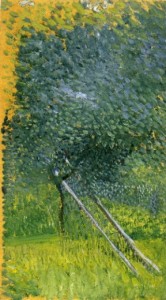
RG38 Obstbaum mit Holzstützen, summer 1907.
Oil on board, 35.5 x 20.5 cms. Private.
Of Gerstl’s 15 or more 1907 landscapes, this is the sole surviving example on board. Clearly bearing many of the pointillistic ideas that Gerstl had developed since the van Gogh show, its tree-supports are typical of the area and suggest that the fruit harvest, which falls in late July/August, was imminent.
Kallir 4 – exhibited at Neue Galerie from opening, 28.9.1931. Thesis – p.158.

RG39 Blumenwiese mit Bäumen, summer 1907. Oil on canvas adhered to board, 36 x 38 cms. Stiftung Sammlung Kamm – Kunsthaus Zug. An example of Gerstl’s grasp of the “plein-air” genre, this, and the next two works, appear to owe much to van Gogh’s Gehölz, which Gerstl surely viewed as exhibit Nr. 26 at the van Gogh show of January 1906. Kallir 12 – exhibited at Neue Galerie from opening, 28.9.1931. Thesis – pp. 159-160.

RG40 Kleines Gartenbild, summer 1907. Oil on canvas adhered to board, 35 x 34 cms. Private. Where Gerstl differs from van Gogh, particularly in this and, for example, RG39, above, and RG41, below, is in his synthesis of tones, which create a sense of infinity and unending distance that is not readily apparent in his later landscapes from that summer. Kallir 15 – exhibited at Neue Galerie from opening, 28.9.1931. Thesis – pp. 159-160.
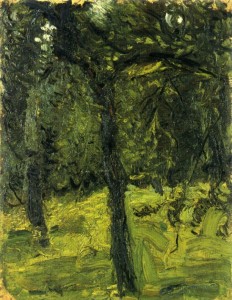
RG41 Baum im Garten, summer 1907. Oil on canvas adhered to board, 43.9 x 34.5 cms. Leopold Museum. These three, predominantly green works have been affectionately dubbed Gerstl’s “Spinat” or “spinach” landscapes. Interestingly, they all portray a hillside route from Engelgut to Feramühle, that, in bridging the mill gullies that brought logs down from the higher slopes to the lake, ran parallel to the road that followed the bank of the Traunsee (see RG42). Kallir 3 – exhibited at Neue Galerie from opening, 28.9.1931. Thesis – pp. 159-160.
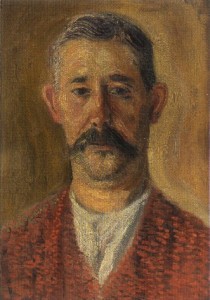
RG28 Bildnis Johann Georg Prillinger, summer 1907.
Oil on board, 50 x 36 cms, inscribed verso: “Richard Gerstl Traunstein 1907”. Private. Gerstl’s portrait of Feramühle’s owner, Johann Georg Prillinger shows a flecking technique that has stylistic affinities to other works painted around the same time, including RG33 Selbstbildnis (Kniestück), and RG36 Selbstbildnis, lachend. This work is one of five or six works painted in Gmunden 1907 on artboard, although only one other, RG38 Obstbaum mit Holzstützen (q.v.) survives. Not known to Kallir. Thesis – p. 155

RG77 Garten, summer 1907. Oil on board, 33.9 x 35 cms. Lost since exhibited by Kallir in 1931, its subject and size, but particularly its use of board, that strongly suggest that this may have been one of the earliest in the series of landscapes that Gerstl painted around his Gmunden farmhouse in summer 1907. Kallir 7 – exhibited at Neue Galerie from opening, 28.9.1931. Thesis – see pp. 155-158.

RG78 Seepartie mit Traunstein, summer 1907
Lost, oil on board, 36 x 50 cms. Plainly one of the series of landscapes painted by Gerstl along the Traunsee in 1907, the use of board again suggests that it was one of his earlier efforts of the vacation. Kallir 8 – exhibited at Neue Galerie from opening, 28.9.1931. Thesis – see pp. 155-158.

RG79 Wienerwaldstudie, summer 1907. Lost, oil on board, 35 x 49 cms. Whilst catalogued by Kallir in 1931 as being a study of the Vienna Woods, it is not beyond possibility that, in view of the size and material, this, too, may have been painted in Gmunden, where a similarity in vegetation could have caused confusion in the description. Kallir 20, but not exhibited at Neue Galerie, 1931. Thesis – see pp. 155-158.

RG80 Wiese mit Obstbaumen, summer 1907. Lost, oil on board, 36.4 x 49.7 cms.The desription of a meadow with a fruit tree, this is entirely typical of the the lower slopes of the Traunstein, which, together with the works size and use of board, again suggests that it may have been amongst the earliest of the landscapes painetd by Gerstl in Gmunden in 1907. Kallir 9 – exhibited at Neue Galerie from 17.10.1931. Thesis – see pp. 155-158.
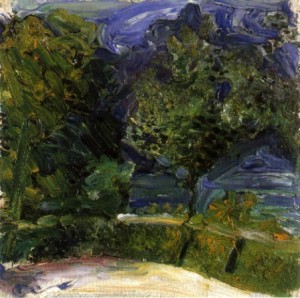
RG42 Uferpromenade bei Gmunden, summer 1907. Oil on canvas adhered to board, 32 x 33 cms. Leopold Museum. The embankment below Feramühle, and first of Gerstl’s lake views in summer 1907, Gerstl here employs flecks and swoops to impart the essence of a windy day into the branches as they bend towards the unusually agitated waters of the lake. Kallir 1 – exhibited at Neue Galerie from opening, 28.9.1931. Thesis – p. 160.
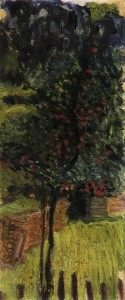
RG43 Obstbaum, July/August 1907.
Oil on canvas adhered to board, 51.5 x 22 cms. Private.
One of three works (RG43—RG45 q.v.) that portray hillside orchards and gardens in bloom around the Feramühle, this is almost certainly a depiction of a pear tree, which bear fruit in August and, when facing towards the sun, often ripen red. Since the tree looks west, with the Traunstein, lying to the east, behind it, and the weather sunnier and more amenable from the beginning of August, this can be assumed to have been painted after then and certainly not during the inclement first few weeks of Gerstl’s vacation.
Kallir 6 – exhibited at Neue Galerie from 17.10.1931. Thesis – pp. 160-161.
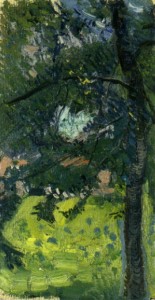
RG44 Baumstudie, July/August 1907.
Oil on canvas adhered to board, 33.8 x 18.3 cms.
Leopold Museum
Gerstl probably painted this study of a tree, with houses in the background, at the same time as RG43, with which it shares its narrow format.
Kallir 10 – exhibited at Neue Galerie from opening, 28.9.1931. Thesis – p. 161.
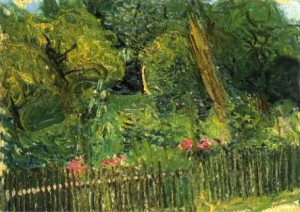
RG45 Blick über einen Gartenzaun, July/August 1907. Oil on canvas adhered to board, 35.3 x 49.7 cms. Leopold Museum. Looking east from the bank below Feramühle, Gerstl’s intense colours suggest early August, with the garden in full bloom. Kallir 13 – exhibited at Neue Galerie from opening, 28.9.1931. Thesis – p. 161.
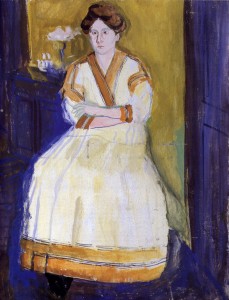
RG34 Mathilde Schönberg:II, probably Summer 1907. Tempera on canvas, 94.2 x 74.6 cms. Österreichische Galerie Belvedere. Gerstl sets Mathilde in a summer dress, demurely against colours typical of the roughly plastered walls of Salzkammergut farmhouses, possibly Engelgut, Schönberg’s summer 1907 accommodation.. Gerstl’s use of a rough, effective, tempera technique suggests that, perhaps in order to seize the pose, the portrait was executed quickly. Kallir 37 – exhibited at Neue Galerie from 17.10.1931. Thesis – pp. 126-128.
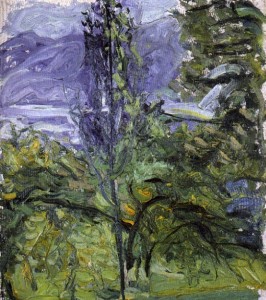
RG46 Kleine Traunseelandschaft, August 1907. Oil on canvas adhered to board, 40.3 x 36.1 cms. Private. As autumn approached, Gerstl seems to have taken a broader vista of the lake, depicting here, for example, the Sonnstein on the western bank in the background. He also begins to dispense with his pointillist roots, although this still retains remnants of Gerstl’s style from earlier in the holiday. Kallir 11 – exhibited at Neue Galerie from 17.10.1931. Thesis – pp. 161-162.
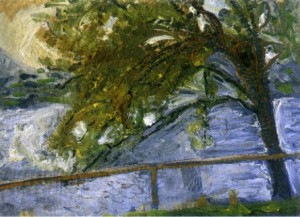
RG47 Baum am Traunsee, September 1907. Oil on canvas adhered to board, 38 x 51.3 cms. Stiftung Sammlung Kamm – Kunsthaus Zug. This view across the lake is dominated by a darkening foliage that recall the fading vestiges of summer. Kallir 21 – exhibited at Neue Galerie from opening, 28.9.1931. Thesis – pp. 162-163.
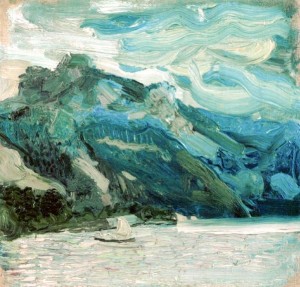
RG48 Traunsee mit “Schlafender Griechin”, September 1907. Oil on canvas, 37.5 x 39 cms. Leopold Museum. “Schlafender Griechin” or Erlakogel, is a peak to the south of the lake, whose outlook is not easily attainable from the eastern shore, so it is likely that Gerstl, having almost entirely dispensed with his earlier pointillism, painted it using broader strokes and swirls whilst in a boat on the lake itself. Not known to Kallir. Thesis – pp. 162-163.
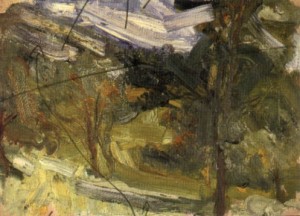
RG49 Landschaftsstudie, August/September 1907. Oil on canvas adhered to board, 37 x 51 cms. Private.The last 1907 Gmunden autumnal work, Gerstl’s broad, almost abstract brushstrokes predict the techniques used in his portraits one year hence. Kallir 17 – exhibited at Neue Galerie from opening, 28.9.1931. Thesis – pp. 162-163.
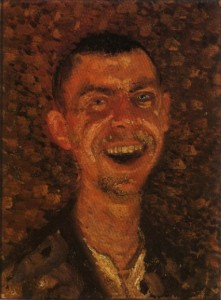
RG36 Selbstbildnis, lachend, summer/autumn 1907. Oil on canvas adhered to board, 39 x 30.4 cms. Österreichische Galerie Belvedere. Using his flecking and dabbing technique to dramatic effect, Gerstl’s agitated background amplifies his nightmarish laugh, dishevelled look, and pleading gaze. Despite this, his appearance bears similarities to William Clarke Rice’s portrait Richard Gerstl, painted in Gmunden in July 1907. Some, though, have suggested that this was Gerstl’s last work and indicative of his pre-suicidal frame of mind, but this conclusion can be firmly dismissed. Kallir 2 – exhibited at Neue Galerie from opening, 28.9.1931. Thesis – pp. 151-155.
♦ ♦ ♦ ♦ ♦ ♦
Click for: 1902-1905 ♦ ♦ 1906 – June 1907 ♦ ♦ Gmunden 1907 ♦ ♦ Autumn 1907 – Spring 1908 ♦ ♦ Summer 1908 – Suicide
Click on the chronological links below to view illustrated details of an individual work:
1902-1905: Zentzytzki ♦ ♦ Bäumer ♦ ♦ Frauenkopf ♦ ♦ Unger:I ♦ ♦ Unger:II ♦ ♦ Blue Self-portrait ♦ ♦ Kinderbild ♦ ♦ Selbstbildnis, lachend (Fragment) ♦ ♦ Schwestern Fey
1906-June 1907: Trude Geiringer ♦ ♦ Schönberg ♦ ♦ Mathilde und Gertrud ♦ ♦ Frau mit Federhut ♦ ♦ Grinzing ♦ ♦ Emil Gerstl ♦ ♦ Selbsbildnis mit Palette ♦ ♦ Diez ♦ ♦ Alois Gerstl ♦ ♦ Smaragda Berg ♦ ♦ Mutter und Tochter ♦ ♦ Selbsbildnis Drawing/1 ♦ ♦ Selbsbildnis Drawing/2 ♦ ♦ Selbsbildnis Drawing/3 ♦ ♦ Selbsbildnis Drawing/4 ♦ ♦ vor dem Ofen ♦ ♦ Selbstbildnis (Studie) ♦ ♦ Kleines Selbstbildnis ♦ ♦ Dame mit Federhut ♦ ♦ Kahlenberg ♦ ♦ Oberländer ♦ ♦ Herrenbildnis ♦ ♦ Kniestück ♦ ♦ Selbsbildnis Drawing/2
Gmunden 1907: Obstbaum mit Holzstützen ♦ ♦ Blumenwiese ♦ ♦ Gartenbild ♦ ♦ Baum im Garten ♦ ♦ Prillinger ♦ ♦ Uferpromenade ♦ ♦ Obstbaum ♦ ♦ Baumstudie ♦ ♦ Gartenzaun ♦ ♦ Mathilde Schönberg:II ♦ ♦ Traunseelandschaft ♦ ♦ Baum am Traunsee ♦ ♦ Schlafender Griechin ♦ ♦ Landschaftsstudie ♦ ♦ Selbstbildnis, lachend (1907)
Autumn 1907-Spring 1908: Self 15 September ♦ ♦ Self 29 September/1 ♦ ♦ Self 29 September/2 ♦ ♦ Liechtensteinpalais ♦ ♦ Donaukanal ♦ ♦ Nußdorf ♦ ♦ Sitzende Frau ♦ ♦ Sitzende Mann ♦ ♦ Mathilde im Atelier ♦ ♦ Halbfigurenportrait ♦ ♦ Henryka Cohn
Gmunden 1908-Suicide: Alban Berg? ♦ ♦ Traunseelandschaft 1908 ♦ ♦ Doppelbildnis ♦ ♦ Zemlinsky ♦ ♦ Mathilde im Garten ♦ ♦ Familie Schönberg ♦ ♦ Gruppenbildnis ♦ ♦ Akt im Freien ♦ ♦ Nußdorferstraße ♦ ♦ Zimmer ♦ ♦ Maria Gerstl ♦ ♦ Halbakt ♦ ♦ Selbstbildnis 12 September 1908 ♦ ♦ Frauenakt
